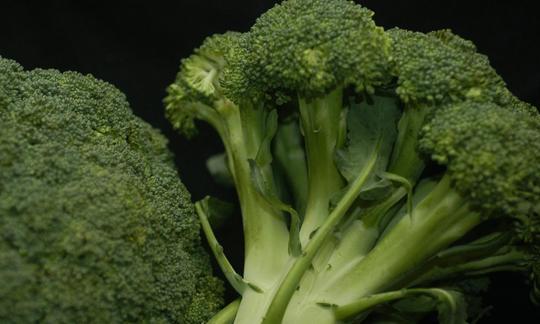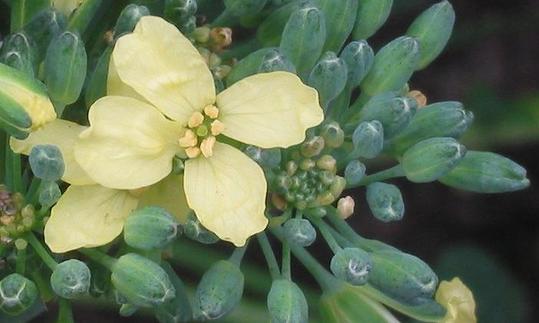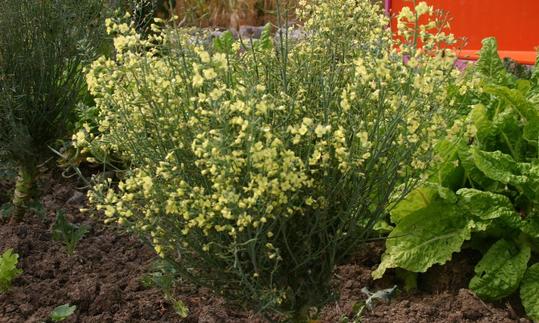Table of contents
With broccoli ( Brassica oleracea var. italica ) the head (the florets , the bunch of flowers ) is most commonly eaten. However , all parts of the plant are edible.
Use in the kitchen:
The flower of fresh broccoli tastes good raw or cooked. Gentle cooking methods such as steaming, boiling or stewing allow the delicate florets to appear crisp and the valuable ingredients are retained. Processed into soups, stews, casseroles, in curries or as a salad, the spicy flower bundles have a very wide range of uses. Asian cuisine also often uses broccoli, for example in sweet and sour and spicy stir-fries or as broccoli tempura.
All parts of the broccoli plant can be eaten raw, for example in a salad or in a smoothie. If your digestion reacts with flatulence, it is better to use only the raw florets and season with fennel seeds or caraway seeds.
How long do you have to cook broccoli? After cutting and washing the broccoli florets, put them in boiling salted water for about 10 minutes. How do I cook broccoli properly? To prepare broccoli as gently as possible, you can cut the head into small pieces and fry it briefly in a pan with oil and then pour a little water over it. Cover and cook for about 8 minutes.
Can you eat the stalk of broccoli? The stalk is also edible, provided the plant is young. Peeled and chopped, its taste is reminiscent of green asparagus.
The characteristic, delicate flavor of broccoli hardly needs any additional seasoning, but it goes very well with salt , nutmeg and garlic . Pine nuts and almond leaves also go well with the cruciferous vegetable. It is also suitable for delicious recipes with curry and ginger, coconut or chili.
Vegan recipe with broccoli in risotto:
Ingredients for 4 servings: 3 onions , 1 garlic clove , 2 tbsp rapeseed oil , 1/4 tsp sambal oelek (or chili powder ), 150 g risotto or short grain rice , ¾ l vegetable stock , 500 g broccoli, 150 g red lentils , salt water, 1 bunch of basil .
Preparation: Finely dice the onions and garlic and sauté in oil until translucent, stir in the sambal oelek. Then add the rice and stir in, gradually adding the hot vegetable stock until the rice has absorbed the liquid. Cover the rice and leave to swell for about 45 minutes, stirring frequently. Wash the broccoli florets and chop them into small pieces. Peel and chop thick stalks, cut thin stalks into slices.
Cook the broccoli and red (peeled) lentils in separate salted water for about 5 minutes and then drain through a sieve. Then mix with the still slightly liquid rice and leave to simmer for another 5 minutes. Pick fresh basil and mix into the risotto just before serving.
| Not only vegans or vegetarians should read this: Vegans often eat unhealthily. Avoidable nutritional mistakes . |
Shopping - where to buy?
Although broccoli is a summer vegetable, you can get it all year round at supermarket chains such as Coop , Migros , Denner , Volg , Spar , Aldi , Lidl , Rewe , Edeka , Hofer etc. In northern Central Europe, the cabbage vegetable is in season between July and October. During these months, you can also find white, yellow, purple or almost black broccoli at weekly markets or in well-stocked supermarkets/greengrocers.
The florets are sometimes available to buy packaged in bowls. However, if you prefer a part of the plant with the stalk, you can also use this for cooking.
Fresh broccoli, as we all know it, is dark green in color and has a firm consistency. If there are spots, rotten spots or yellow flower buds, the vegetable is clearly no longer fresh. Due to its sensitivity to mechanical damage, broccoli is often found wrapped in foil. 1
Wildly found:
Brassica oleracea , the vegetable cabbage, is a wild subspecies of the cabbage plants of our cultivated cabbage species. It is not possible to say for sure whether it is really their "ancestor". If cultivated cabbage varieties are allowed to seed, they sometimes revert to this wild form. Externally, this species resembles mustard with its yellow flowers and long false ears, but has thicker, greyish, fleshy leaves. If you eat the leaves of the wild cabbage raw, they taste bitter. After a longer cooking time, they lose this bitterness and are tastier. 2
Storage:
Broccoli has a very high metabolic activity, which means that it quickly loses valuable ingredients. In addition, the florets are very sensitive and susceptible to putrefaction pathogens. Pre-cooling at around 0.5 °C immediately after harvest and a very high humidity of 96-99% would be ideal. This is mainly the case in CA storage (Controlled Atmosphere). 1
After purchase, broccoli can be stored in the foil in the refrigerator for up to 3 days. High temperatures and light cause broccoli to wilt or bloom (ie turn yellow) quickly. In addition, it loses at least 10% of its vitamin C content every day in warm temperatures. 3 If you divide the head into small florets, you can blanch them briefly and then quickly freeze them.
Typical storage damages are spotting and rot ( Botrytis cinerea , bacterial soft rot, Alternaria brassicae, Sclerotinia sclerotiorium, Peronospora parasitica ). 1
Ingredients - nutritional value - calories:
The broccoli florets only have about 28 kcal/100g, which is due to the high water content of over 90%. The carbohydrates make up 5.1 g, the protein 3 g and the fat only 0.35 g/100g. 4
Broccoli scores highly with its vitamin C content of 93 mg/100g. That is more ascorbic acid than can be found in strawberries (59 mg) or aronia berries (81 mg). A lot of the water-soluble vitamin can be lost through long cooking or dissolve in the cooking water. As a radical scavenger, vitamin C is important for a stable immune system. 4
Broccoli contains 71 µg/100g folate , which doesn't sound like a lot considering the daily requirement of 300 µg 5 . A combination with pulses such as mung beans (625 µg/100g) or lentils (479 µg/100g) makes a lot of sense here. A sufficient supply of 550 µg 5 daily is particularly important BEFORE pregnancy, as the water-soluble vitamin plays a central role in cell renewal.
The flower bunches contain 150 µg of vitamin A per 100 g. In the form of carotenoids, it is also found in abundance in carrots (835 µg/100g). But not only yellow or orange vegetables have a lot of this fat-soluble vitamin, but also green vegetables such as kale (500 µg). In addition to its essential role in the vision process, it is also important for growth.
The green flowers also contain potassium , manganese and phosphorus .
Health aspects - effects:
The increasing popularity of broccoli is not only due to the fact that it has less of a cabbage taste than cauliflower, for example, but also because it is easier to digest. In addition to its properties that are gentle on the stomach and intestines, broccoli also has positive properties for a healthy heart. The balanced sodium-potassium ratio promotes the excretion of excess fluid and thus relieves the cardiovascular system. 6
Like all cruciferous vegetables, broccoli contains sulphur-containing secondary plant ingredients that protect against insect pests and act as natural antioxidants. 7 These mustard oil glycosides are also said to have a preventive effect against cancer. 8 In particular, an indole-containing derivative of L-ascorbic acid, ascorbigen, is said to have an anti-carcinogenic effect. 9
Sulforaphane, a mustard oil that acts as an indirect antioxidant, is said to be supportive in conventional cancer therapies. By activating phase II enzymes, cancer cells, such as those in pancreatic or prostate cancer, are vulnerable to chemotherapy, for example. 10,11 Sulforaphane from broccoli sprouts is also said to be effective against the stomach-damaging bacterium Helicobacter pylori , against which even some antibiotics fail. 12
Other secondary plant substances include anthocyanins, which are found particularly in dark green (or purple) broccoli. These water-soluble plant pigments bind free radicals in the body and protect it from damage.
Unfortunately, it is not always clear how much of the healthy cabbage vegetable you should eat to achieve positive effects. In any case, about 1 spoonful of broccoli sprouts contains the same amount of the mustard oil glycoside sulforaphane as 500 g of broccoli vegetables.
Dangers - Intolerances - Side effects:
Allergies to brassicas are rare, although contact allergies sometimes occur. Intolerances are more common in people with sensitive gastrointestinal tracts. Cruciferous vegetables can cause stomach problems and flatulence.
Use as a medicinal plant:
The ingredients of broccoli are used for simple respiratory diseases, but also for asthma, hay fever and chronic lung diseases. 13
Occurrence - Origin:
Originating in Asia Minor, it came to Europe via Italy. In England in the 16th century it was called "Italian asparagus", from there it reached America in the 18th century, where breeding was intensified. In Europe, the main growing areas are in Verona (Italy).
Growing in the garden or as a potted plant:
Broccoli is almost exclusively the result of so-called CMS breeding methods. Even the organic varieties are hybrids and therefore male sterile (CMS = Cytoplasmic male sterility). Although organic plant breeders are very interested in non-hybrid broccoli varieties, these unfortunately produce much lower yields and are therefore much more expensive for consumers. 7
Broccoli is usually grown from young plants. Sowing seeds is much more laborious, but it is a good idea because you get seeds for the next year. Young plants are planted between the end of May and the end of July at a distance of 50 x 50 cm on particularly nutrient-rich soil. The plants are covered with a net to protect them from birds.
During growth, broccoli needs sufficient and regular water, but otherwise has few demands.
The harvest takes place as soon as the middle flower is well developed but still closed. The flower heads are cut off with a stem about 10-15 cm long. If the plant is allowed to continue growing, further, slightly smaller flower heads will develop from the side buds. If the flowers have already opened, the broccoli is still edible (non-toxic!), but can have a bitter taste.
Broccoli is affected by pests such as the whitefly or the caterpillars of the cabbage white butterfly, which can sometimes cause major damage. Since clubroot (caused by Plasmodiophora brassicae ) can also occur, a wide crop rotation is very important for brassica vegetables.
General information:
Broccoli ( Brassica oleracea var. italica ) was bred from the diverse plant species of cabbage ( Brassica oleracea ). Cauliflower ( Brassica oleracea var. botrytis ) also comes from the same species and is a very close relative. Both broccoli and cauliflower belong to the flowering or budding vegetables (both terms from the food trade). Their flowers/buds are harvested before they open, otherwise the aroma will diminish or they will be bitter or harder to digest.
Alternative names:
Wikipedia also lists well-known names such as broccoli, sprout cabbage, asparagus cabbage, and winter cauliflower. But the spelling can also vary: from broccoli to brokoli or broccoli to brocoli. This name is derived from the Italian il broccolo (flowering cabbage), which in turn is the diminutive of brocco (small nail, sprout, bud, shoot), and thus comes from the term Brussels sprouts. 14,16,17
In English, this brassica is known as broccoli, asparagus broccoli or calabrese. 7 The flower clusters are also called broccoli flower clusters.
Other uses:
Broccoli seed oil is also produced from the seeds, which is used in cosmetics as a hair and facial care product. 15
Literature - Sources:












Comments